Voltage Lockdown: Investigating AMD's Recent AM5 AGESA Updates on ASRock's X670E Taichi
by Gavin Bonshor on May 16, 2023 12:00 PM EST- Posted in
- CPUs
- AMD
- ASRock
- Motherboards
- X3D
- Ryzen 7000
- X670E Taichi
- AGESA
AGESA 1.0.0.5c to 1.0.0.7: Differences With ASRock's X670E Taichi Firmware
Before we head into the testing, we figured it would be a good idea to highlight what we found different (if anything) within the BIOS of ASRock's X670E Taichi motherboard when updating the firmware from each successive version. Although nothing has changed from a GUI perspective, we can at least see some of the main settings that ASRock is presetting once AMD's EXPO memory profiles are enabled.
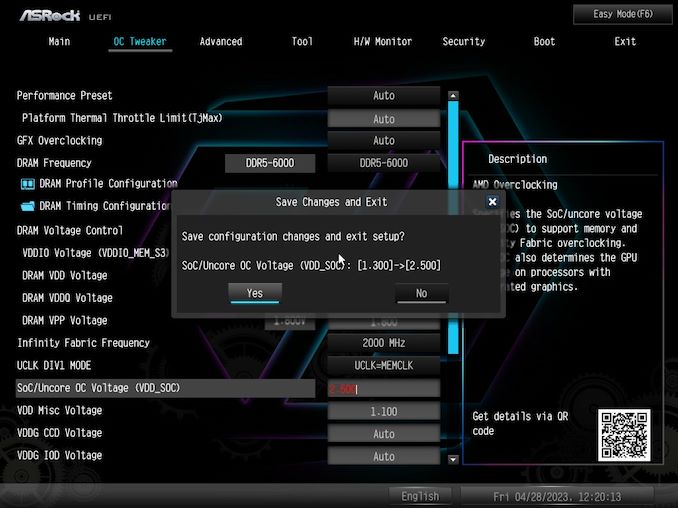
Screenshot of ASRock X670E Taichi UEFI firmware: BIOS 1.18 (AGESA 1.0.0.5c)
While nothing has changed in regards to the GUI, the most significant change from going from AMD's initial Ryzen 7000X3D-enabled BIOS is that users were able to set crazy levels of SoC voltage; the X670E Taichi would let us put 2.50 V on the SoC, which is ridiculously dangerous. As a reminder, the Ryzen 7000X3D chips are non-overclockable from a core frequency and VCore perspective, though they do support AMD EXPO memory profiles.
ASRock is clearly overshooting SoC voltage to ensure stability for users. When applying AMD EXPO on supported DRAM, all of ASRock's X670E Taichi firmware variants from AGESA 1.0.0.5c to the latest BETA AGESA 1.0.0.7 (BETA) variant, the firmware would automatically apply 1.30 V to the SoC voltage, regardless of what memory frequency is used. If users opt for a lower spec kit such as DDR5-6000 with EXPO, applying 1.30 V is a little overkill, as we found it made no difference to stability until we went below 1.25 V on the SoC voltage.
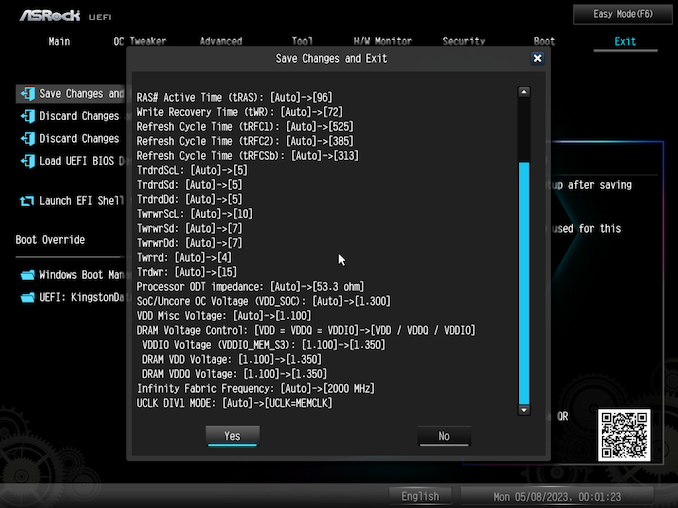
ASRock X670E Taichi firmware applying changes when using EXPO on our DDR5-6000 EXPO kit.
Looking at the changes that applying memory with an AMD EXPO profile has on the settings, we can see that ASRock automatically changes some key voltage settings relating to SoC, VDDIO, DRAM VDD, and DRAM VDDQ. As we previously mentioned, ASRock automatically applies 1.30 V to the SoC voltage when you use EXPO memory profiles, or even XMP 3.0 profiles, as we found out. The VDD misc voltage was set to 1.10 V from auto, with the DRAM voltage (DRAM VDD/VDDQ) increasing to 1.350 V from 1.10 V. As per the memory specifications and how AMD's Infinity Fabric works, the firmware automatically applied 2000 MHz for Infinity Fabric and changed the UCLK DIV from auto to equal the MEMCLK.
AMD AGESA 1.0.0.5c Up to 1.0.0.7: Analysis, Testing For Differentials
For our analysis of the changes that AMD's updated AGESA firmware has on specific variables when put under heavy and intensive memory-focused workloads, we'll be splitting the sections into two; memory at the JEDEC default specifications (settings on auto) and with EXPO enabled (DDR5-6000 CL34).
G.Skill Trident Z5 at DDR5-5200 (JEDEC) Settings
The key variables we'll be focusing on include the following:
- Peak Temperatures across the CPU die, CPU CCD1 (3D V-Cache), and CPU CCD2 (in °C)
- Peak Voltages including CPU VDDCR/VDD, CPU VDDR_SoC (SoC Voltage)
- Peak Current, including CPU Core current and SoC current (in amps)
- Peak Power, including CPU PPT (from the AM5 socket) and SoC power
In our results, the CPU die temp max average is an average of both CCD1, CCD2, core temperatures and L3 cache temperatures. This isn't to be confused with the average of the CPU die temp average.
Starting with peak temperatures across both CCDs and the die, going from AGESA 1.0.0.5c to AGESA 1.0.0.7 (BETA), we can see that the CCD2 (non-V-Cache) was noticeably higher by just under 25%. The CCD (1) with 3D V-Cache was relatively consistent regarding peak temperatures, with a jump of just 2%. Overall, the CPU die temp, as with CCD1, was higher due to the different core temperatures on CCD2.
We can see that going to AGESA 1.0.0.6 from 1.0.0.5c resulted in slightly lower temperatures across all of the CCDs and overall die temp, but the latest AGESA 1.0.0.7 (BETA) (at the time of writing) was the hottest of all. One possible reason for the higher temperatures on AGESA 1.0.0.7 is that reducing power from the one component of the CPU, in this case, the SoC allows the actual Zen 4 cores slightly more headroom in terms of power.
Looking at the average temperatures across CCD1 and CCD2 and the overall die temperature, we can see that there wasn't much variance between the different AGESA versions. Even on AGESA 1.0.0.7 with a higher temperature peak, the average is much more in line with the other AGESA versions.
Focusing on voltages, including CPU VDDCR_VDD (memory voltage) and CPU VDDR_SoC voltages, we can see they are consistently within acceptable margins. While we're not focused on CPU VCore as it's well within specification, and hasn't been an issue as the Ryzen 7000X3D series chips are core frequency/voltage locked, the SoC and memory voltages are well within expected levels in line with our G.Skill Trident Z5 Neo DDR5-6000 memory's specifications.
Although we observed higher temperatures across the board on AGESA 1.0.0.7 (BETA) without AMD's EXPO enabled, we can see that AGESA 1.0.0.5c's current peaked higher. While sustained current and voltages can spike higher than the averages, they aren't sustained and shouldn't be of concern, at least not from our testing.
Focusing on the averages of both the SoC and CPU Core currents, we can see that AGESA 1.0.0.6 is slightly more reserved than the initial Ryzen 7000X3D series launch firmware and the latest AGESA 1.0.0.7 (BETA).
The actual power values monitored using HWInfo show that AGESA 1.0.0.7 (BETA) has a higher peak power from the socket (PPT) than the two other AGESA versions. As we've seen from our testing, AGESA 1.0.0.6 with our ASRock X670E Taichi is more conservative on current and power, so temperatures are lower across the board. Pulling more power from the socket with AGESA 1.0.0.7 (BETA) and our Ryzen 9 7950X3D does explain why temperatures are higher, both at peak and average.
Our testing shows that AMD's AGESA 1.0.0.7 (BETA) is consistent with other AGESA firmware versions at default memory settings. Still, we can see an increase in power draw and temperatures, at least on the ASRock X670E Taichi.
G.Skill Trident Z5 at DDR5-6000 (EXPO Enabled) Settings
Now onto our testing with the AMD EXPO memory profile enabled on our G.Skill Trident Z5 Neo DDR5-6000 CL34 kit. We've added another variable, with our DDR5-6000 kit also running with an applied SoC voltage of 1.25 V in the firmware.
A closer look at peak temperatures shows a slight variation between all three AGESA firmware variants. Using AMD AGESA 1.0.0.7 (BETA) with 1.25V on the SoC voltage, CCD2 peaked at 55.5°C, the CCD without the 3D V-Cache. This was a noticeably higher spike than expected, given that SoC voltage was inherently lower than the other runs (1.30 V on the SoC).
Interestingly, the initial launch BIOS (AGESA 1.0.0.5c) for Ryzen 7000X3D processors ran with the lowest temperature on CCD2, and we observed the lowest spike in temps on CCD1 (3D V-Cache) too. Looking at the maximum CPU die temperature average, all were within quite acceptable margins, with nothing noteworthy in this regard and nothing out of the ordinary.
Moving to the average temperatures, we see things are much more balanced between the three AMD AGESA firmware versions. AGESA 1.0.0.7 (BETA) at 1.25 V on the SoC voltage still averaged slightly warmer on the non-3D V-Cache enabled CCD than on AGESA 1.0.0.5c, which was less on average compared to AGESA 1.0.0.6.
Concentrating on peak voltages across both the memory and CPU SoC voltages, we can see that AMD AGESA 1.0.0.6 peaked slightly higher on memory voltage than the other revisions. SoC voltage is consistent across all three AGESA variants at 1.289, showing that ASRock's firmware automatically setting 1.30 V for SoC is working well. At 1.25 V on AGESA 1.0.0.7 (BETA), our SoC voltage reading topped out at 1.239 V, which shows a bit of negative VDroop, a positive in this case.
Again, AGESA 1.0.0.6 is operating with more courage as it pulls more amps than other versions; it's interestingly peaking at a higher current on the SoC voltage than the firmware before it, AGESA 1.0.0.6. It would have been thought that AMD's quick fix BIOS to address SoC voltages would peak at lower variables, and it peaks around half an amp higher than the latest AGESA 1.0.0.7 (BETA) firmware.
Even setting 1.25 V on the SoC, the amperage pulled from the rail responsible for the SoC is lower than 1.30 V, which is expected as less power is fed through it. Although we didn't experience any reported problems in our testing, CPU core current spiked higher on AGESA 1.0.0.6 than the other versions.
Focusing on average amps drawn from the SoC, things on the SoC balance back to expected levels, although there is not much variation comparing all three AGESA firmware. On average, with AGESA 1.0.0.6 and 1.0.0.7, we can see that the average CPU core current is noticeably higher than AGESA 1.0.0.5c, which is the initial launch BIOS for the X670E Taichi for Ryzen's 7000X3D series.
Lastly, the peak power output with AMD's EXPO memory profile enabled on our Ryzen 9 7950X3D with the ASRock X670E Taichi. As we can see, AMD AGESA 1.0.0.6 peaked out over 5 W higher on the AM5 socket than the other versions, and AGESA 1.0.0.5c seems to be the most conservative regarding this. For SoC power output, AGESA 1.0.0.6 spikes higher on power than the different versions, which could be one of the reasons that AMD replaced AGESA 1.0.0.6 so quickly.


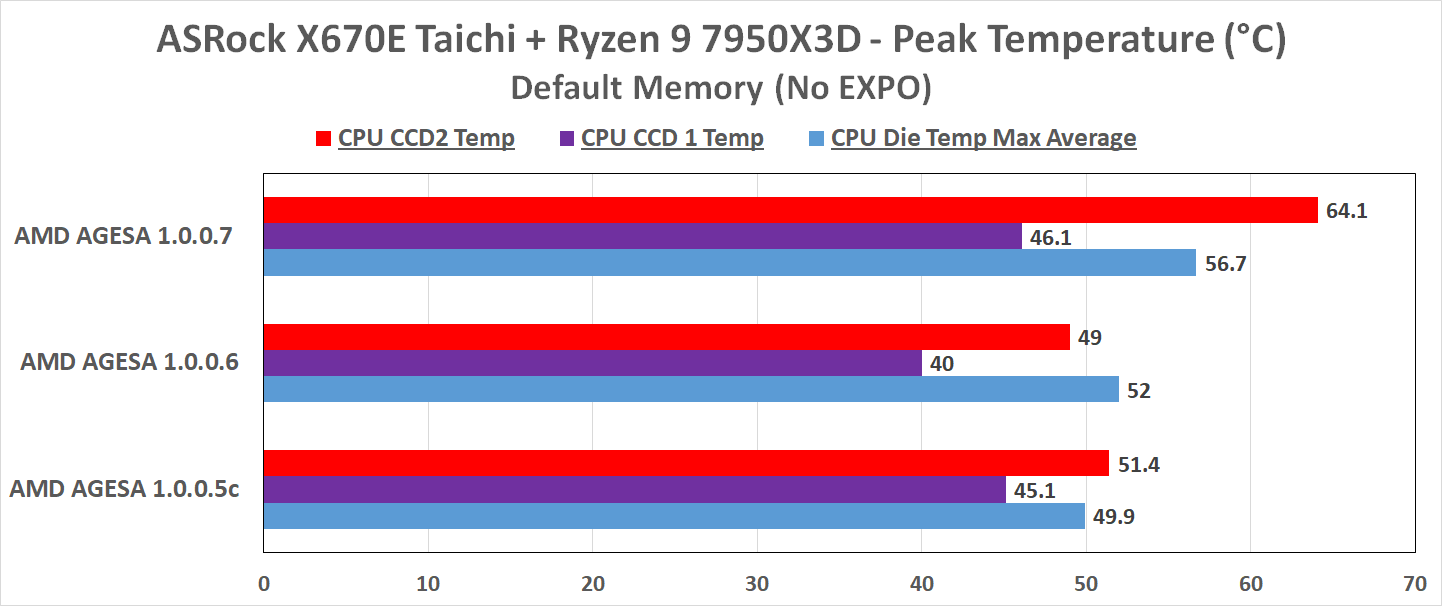
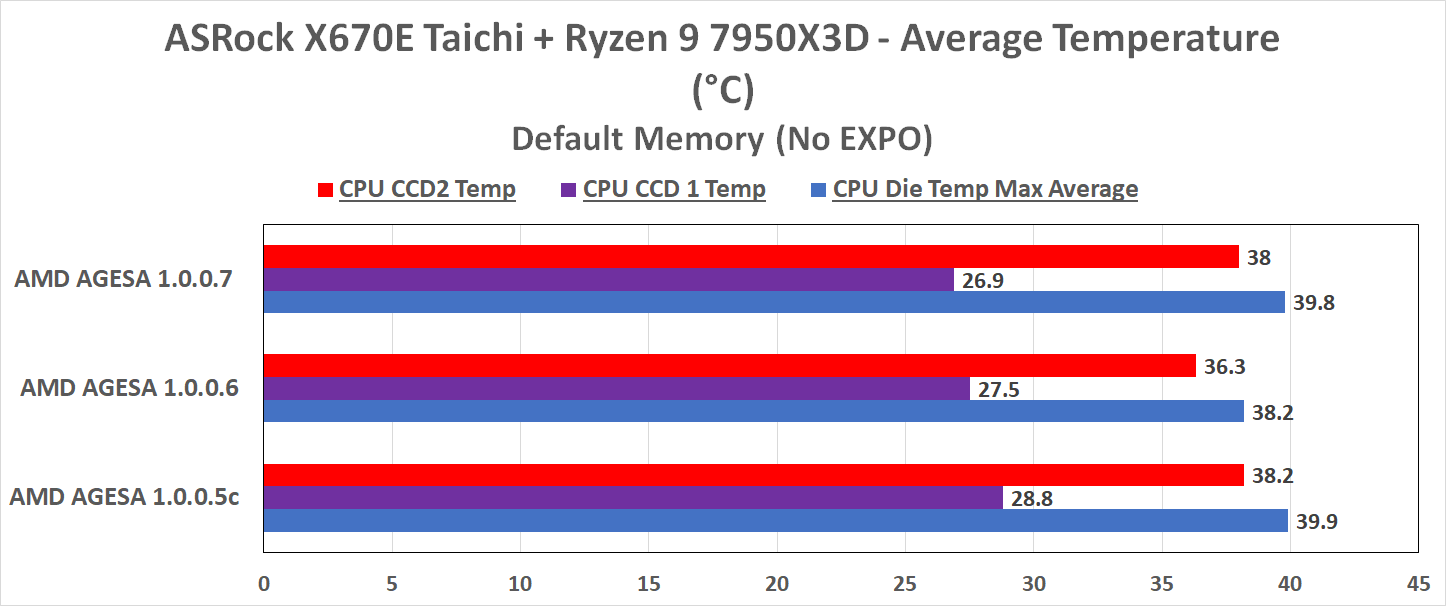
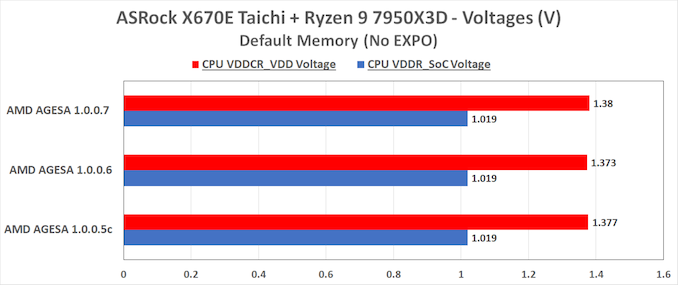
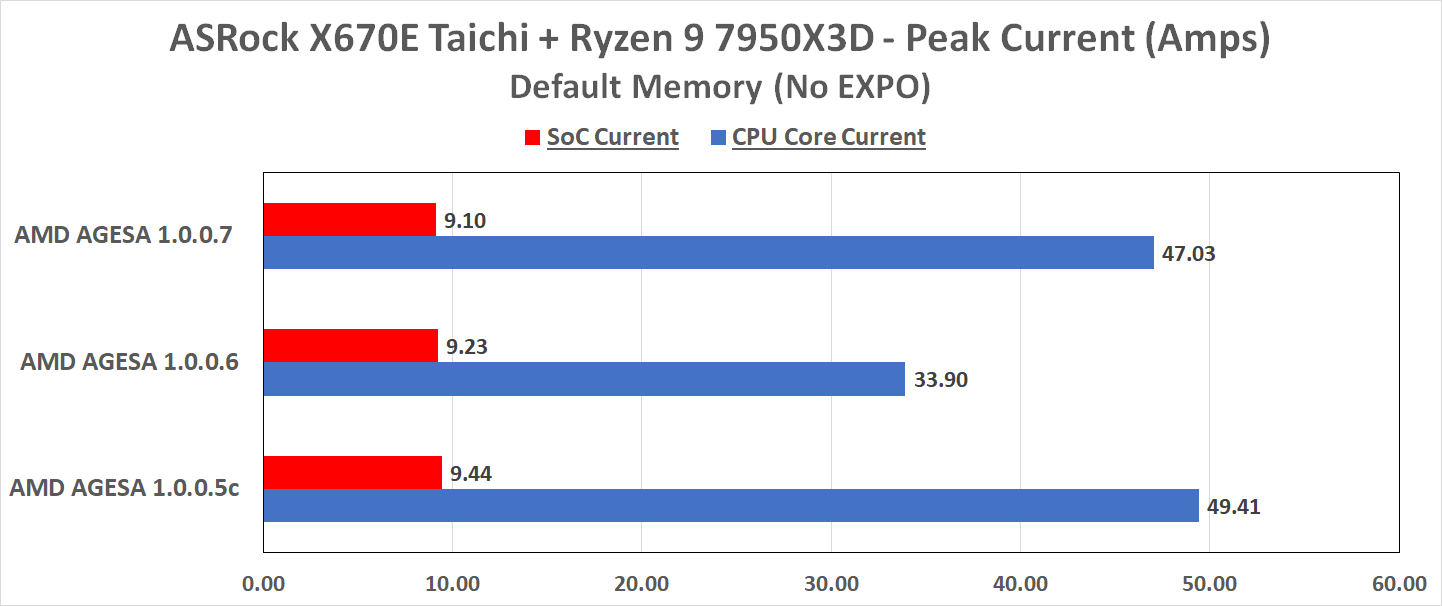
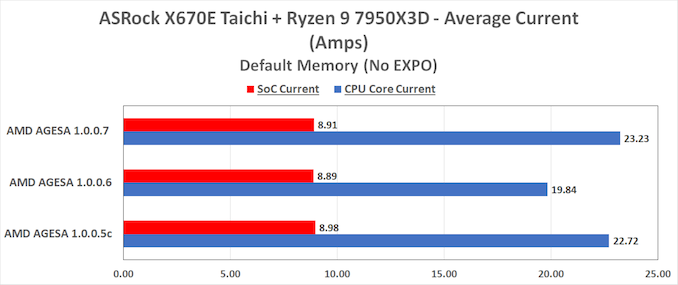
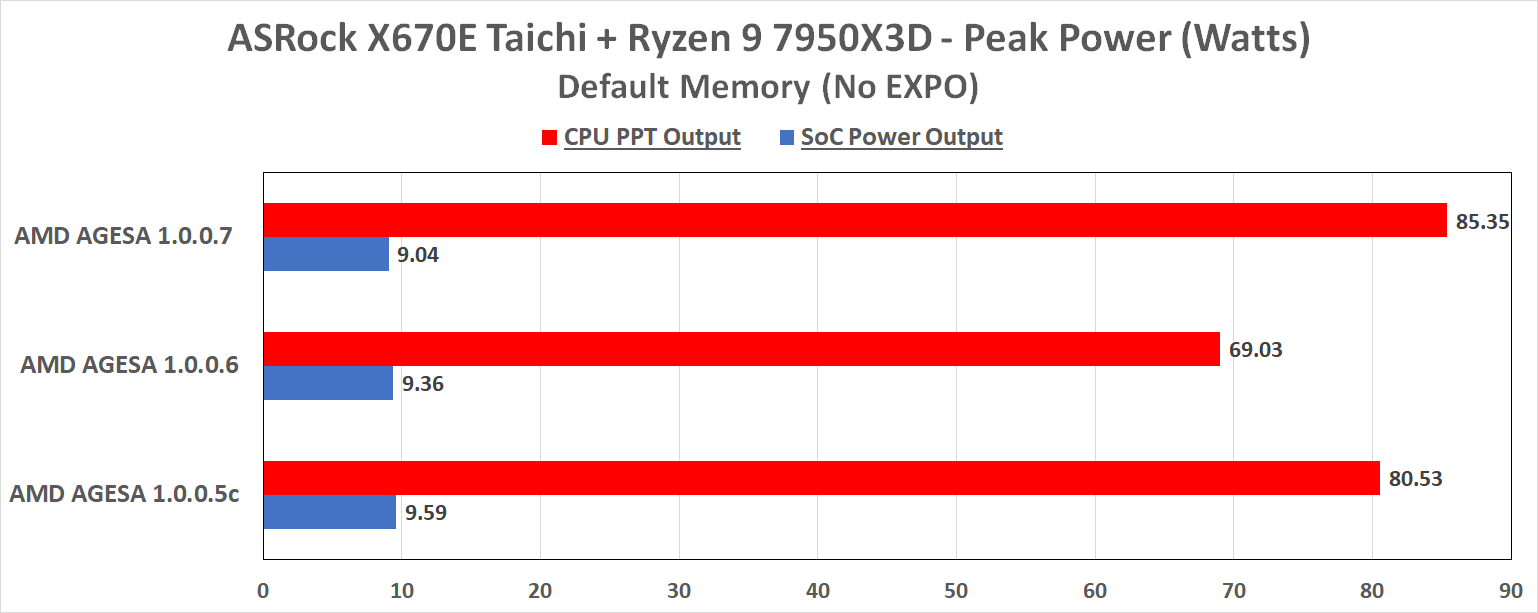
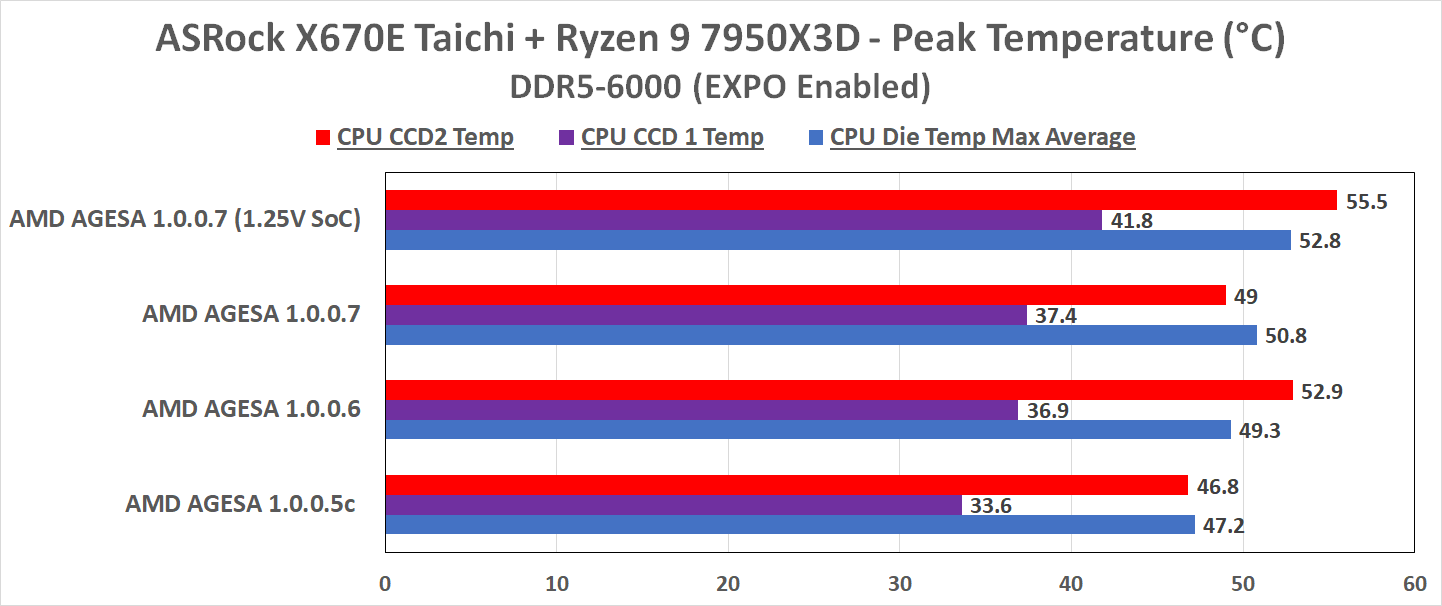

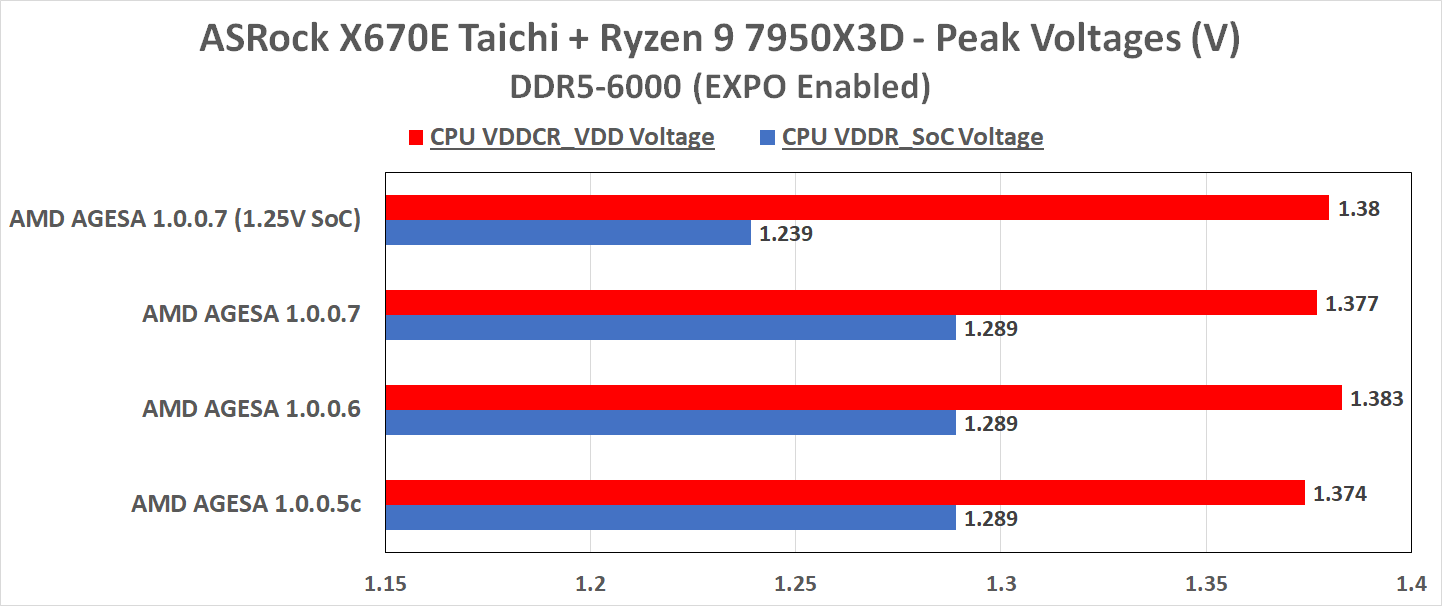


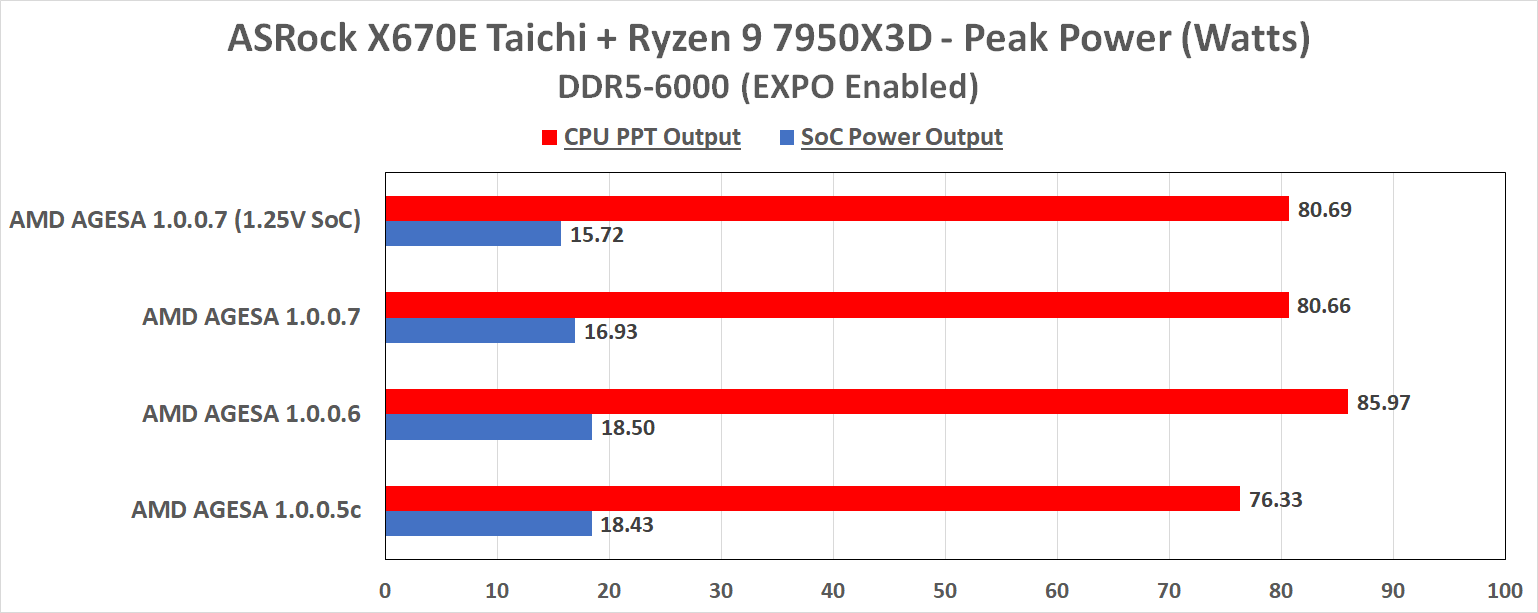








39 Comments
View All Comments
haplo602 - Thursday, May 18, 2023 - link
but they brag about the sunk cost and beg for shop purchases throughout the whole video ...they could have at least tried a regular 7800 in the same mobo and compare the voltage readings to have at least something relevant ...
dan121loveu - Wednesday, May 17, 2023 - link
Gamernexus premise on poor SOC overvolt is wrong. You have to question if their other findings are reliable. Unofficial Asus video on die sense and socket sense, not a new thing, they had one few years back in the same channel. They have even put this features in their ROG X670E homepage. Auto-translate to english video here https://www.youtube.com/watch?v=l8r4LVV_jsQSilver5urfer - Wednesday, May 17, 2023 - link
Very interesting and a good video.Major takeaway point are - Die Sense is enabled on default for the C8H and other premium ASUS boards, and GN has same board, and that means HWInfo should actually show proper data. This is like those premium Intel boards which have a switch that allows directly reading from Die Sense on the fly (HWinfo helps to spit out that data). Only diff here it's already default you get 2 measurement points to compare it to !
So GN fked up by using the farthest point, and they did not even check or bothered to check the HWinfo reading when they are doing their big space age big brain investigation and throw a bunch of terms at the audience to confuse massively. 1M views already are not free so the sensationalism has to get the maximum coverage skipping all the points in the middle and it works, always did because avg consumer is a dumb rock.
I presume AT's X670 Taichi is also similar design, so the VSoC reading is accurate (guessing). Now if you go to Igor's Lab they have a Gigabyte Aorus X670E which is also using Mobo read points, they make the similar mistake like GN using board readouts farthest ones to measure the Voltages which gives them again wrong picture how GB is also shoving 0.03-0.05 volts more despite the new AGESA, and they are ignoring the HWinfo readings as I see only one measurement result from them too. Why not just double check the HWInfo readings instead go for the singular measurement point ?
Top notch journalism nowadays lmao..
haplo602 - Thursday, May 18, 2023 - link
so you boot up the system into BIOS/UEFI, change the settings you want to test and then it reboots and fries the CPU right away ... HOW do you get anything from HWinfo there when you did not even make it to Windows with a functional CPU ? but I am sure you would figure out a way genius ...Silver5urfer - Thursday, May 18, 2023 - link
You completely seem to miss the point. Let alone understand this. I'm talking about the behavior while you are talking about a scenario of all CPUs are dying and so boo hoo I cannot get a read out. If I had an Intel board I'd knew it because I as I alr mentioned I know Die Sense on Apex exists directly.Techie2 - Wednesday, May 17, 2023 - link
The key takeaway for me is that the majority of mobo makers caused the burnouts by automatically bumping the SoC voltages too high when EXPO is enabled. It does not surprise me at all that Asus had excessive voltage. IME they always push the envelope to get minutely better performance numbers and great reviews. It does not surprise me that Asrock used a proper mobo design. They have been doing this for many years IME.dicobalt - Thursday, May 18, 2023 - link
This reminds me when Intel released Core was first released and the memory controller would get easily fried. I was one of the fryers.biostud - Friday, May 19, 2023 - link
I'm using the 1.21 BIOS with 1.0.0.6 AGESA in my ASRock X670E PRO RS, it only applies 1.25V voltage for vSoc on my 7800X3D.GreenReaper - Saturday, May 27, 2023 - link
And that's likely all you need. It's both the minimum and maximum for me - I wasn't able to go beyond 1.25V (which incidentally measured as 1.272V...) without running into issues, while going below it showed computation errors in y-Cruncher's HNT test - a great tool for diagnosing Infinity Fabric instability, which also applies to BOINC tasks.